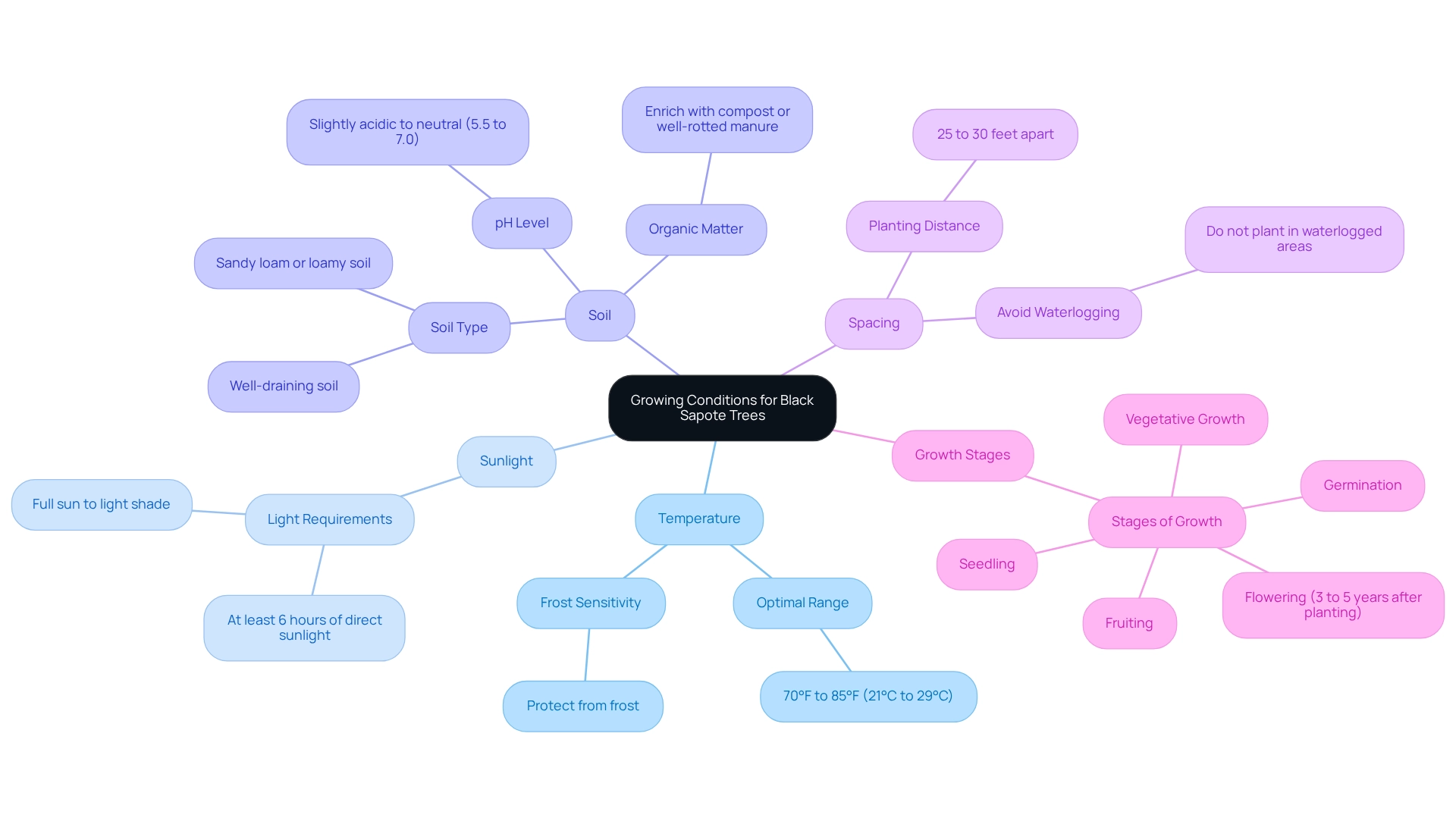
How to Grow Black Sapote Tree (A Fruit That Tastes Like Chocolate Pudding)
Share
Looking for an exotic, low-maintenance fruit tree that gives you dessert from nature? Meet the Black Sapote—aka the "chocolate pudding fruit." With creamy, sweet flesh and rich flavor, it’s a hit among home growers. This guide walks you through everything you need to start growing your own Black Sapote at home—from planting to troubleshooting.
🌳 Want your own chocolate-like fruit tree? Shop Black Sapote Tree →
In the world of tropical gardening, few fruits capture our imagination quite like the Black Sapote, affectionately known as the "chocolate pudding fruit" for its rich, sweet flesh. If you've ever yearned to cultivate this unique tree, you're not alone; many gardeners find this endeavor both exciting and rewarding. However, it’s essential to understand the specific growing conditions and care requirements that will help your Black Sapote thrive.
Understand the Growing Conditions for Black Sapote Trees
-
Temperature: For optimal growth, aim for temperatures between 70°F to 85°F (21°C to 29°C). It's important to protect your tree from frost, as it can be sensitive to the cold.
-
Sunlight: Select a location that enjoys full sun to light shade. Ideally, your black sapote tree should receive at least 6 hours of direct sunlight each day to ensure a bountiful harvest.
-
Soil: Well-draining soil is crucial. The black sapote tree prefers a slightly acidic to neutral pH, ideally between 5.5 to 7.0. Enrich your soil with organic matter, such as compost or well-rotted manure, to boost fertility and drainage. Sandy loam or loamy soil works best.
- Spacing: When planting saplings, give them plenty of room—at least 25 to 30 feet apart. This spacing allows for proper air circulation and growth. Be mindful of where you plant; avoid areas prone to waterlogging, as these plants do not tolerate standing water well.
Understanding these essential conditions is key to nurturing a healthy fruit plant. Remember, patience is vital; the flowering stage typically occurs 3 to 5 years after planting. Each stage of growth—from germination to fruiting—requires your care and attention. As Kiersten Rankel, a Master Black Persimmon cultivation expert, wisely advises, 'If you're considering growing the black sapote tree, focus on the warmer states like Florida, California, and Hawaii.' By meeting these criteria, you can create an ideal environment for the black sapote tree to thrive, embracing the beautiful influence of your climate on its growth.

Plant the Black Sapote Tree: Step-by-Step Instructions
- Choose the Right Time: Begin your journey in early spring, after the last frost. This timing gives your plant the best chance to establish itself and flourish.
- Prepare the Planting Hole: Dig a hole that is twice as wide and deep as the root ball of your plant. This extra space allows the roots to spread comfortably, promoting healthy growth.
- Soil Preparation: Enhance the excavated soil by mixing it with organic matter like compost. This simple step improves drainage and enriches the nutrient content, setting your plant up for success.
- Position the Plant: Carefully place your plant in the center of the hole, ensuring that the top of the root ball is level with the surrounding soil. Avoid planting too deep, as this can lead to root rot, which we certainly want to prevent.
- Backfill the Hole: Gently fill the hole with your prepared soil, tamping it down lightly to remove air pockets. Water thoroughly to help settle the soil around the roots, providing them with a nurturing environment.
- Mulch: Apply a 2-3 inch layer of mulch around the base of your plant, making sure to keep it away from the trunk. This helps retain moisture and suppress weeds, allowing your plant to thrive.
- Watering: Consistent irrigation is crucial, especially in the initial weeks after planting. This care will assist in establishing strong roots, ensuring your plant's success.

Maintain Your Black Sapote Tree: Care and Maintenance Tips
- Watering: It's important to maintain consistent moisture, especially during dry periods. The black sapote tree thrives in moist, well-drained soil, so be mindful of overwatering, which can lead to root rot. Adjust your watering routine based on how your plant responds to the environment.
- Fertilization: Applying a balanced fertilizer, like 8-8-8 or 10-10-10, every six months can support robust growth. The best times for fertilization are early spring and late summer, aligning with the tree's natural growth cycles.
- Pruning: Annual pruning is key to eliminating dead or overcrowded branches. This practice enhances air circulation and sunlight exposure, both vital for fruit production. As agricultural specialist Kiersten Rankel beautifully puts it, "Pruning your black sapote tree isn't just a chore—it's an art that optimizes growth."
- Mulching: Keeping a layer of mulch around the base of the plant helps conserve moisture and suppress weed growth. Remember to refresh the mulch periodically to maintain its effectiveness.
- Pest Management: Regularly check for common pests like aphids and mealybugs. If you notice infestations, neem oil or insecticidal soap can be effective solutions for control.
- Disease Prevention: Promoting good air circulation around the plant and avoiding overhead watering can significantly reduce the risk of fungal diseases.
- Strategic Pruning: Making thoughtful cuts on specific branches encourages the plant to focus its energy on producing fruit, leading to better yields.

Troubleshoot Common Problems in Black Sapote Cultivation
- Leaf Yellowing: This often signals overwatering or nutrient deficiencies. To address this, check the soil moisture levels and consider applying a balanced fertilizer to restore essential nutrients.
- Poor Crop Development: If your plant produces blossoms but fails to yield fruit, it may be due to insufficient pollination or nutrient imbalance. Ensuring proper fertilization and considering hand-pollination can greatly enhance fruit development. It’s also important to note that abnormal flower development can manifest as deformed flowers or blooms that fail to open, which may require early intervention to promote healthy growth.
- Pest Infestations: Keep an eye out for pests like aphids or scale insects. You can effectively manage these nuisances using neem oil or insecticidal soap, which will help eradicate them without harming your plant.
- Fungal Issues: If you notice dark spots on leaves, this may indicate a fungal infection. Improving air circulation around the plant and avoiding overhead watering can be beneficial. If needed, applying a suitable fungicide can help control the spread.
- Root Rot: This condition often arises from overwatering or poor drainage. Ensure your chocolate pudding fruit is planted in well-draining soil and adjust your watering schedule to prevent excess moisture.

Conclusion
🍮 Grow Your Own Chocolate Pudding Fruit
You don’t have to be a pro gardener to enjoy exotic fruit at home—Everglades Farm makes it easy with hand-selected trees, simple care guides, and quick shipping from sunny Florida.
Whether you're craving rich Black Sapote, creamy guava, or tropical lychee, your home orchard starts here.
Frequently Asked Questions
What climate is suitable for growing the black sapote tree?
What temperature range is optimal for black sapote growth?
How much sunlight does a black sapote tree need?
What type of soil is best for black sapote trees?
How far apart should black sapote saplings be planted?
What should be avoided when planting black sapote trees?
How long does it take for a black sapote tree to flower after planting?
Which states are recommended for growing black sapote trees?



